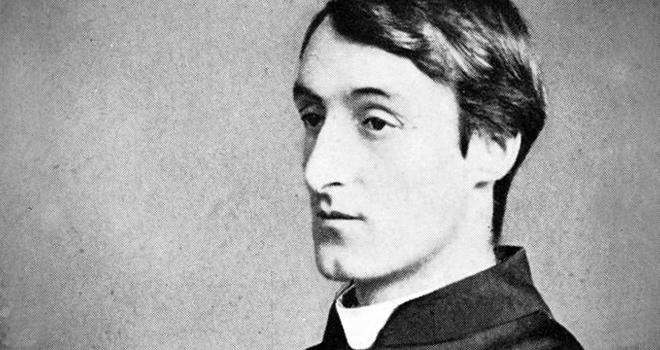For how to the heart’s cheering
The down-dugged ground-hugged grey
Hovers off, the jay-blue heavens appearing
Of pied and peeled May!
Blue-beating and hoary-glow height; or night, still higher,
With belled fire and the moth-soft Milky way,
What by your measure is the heaven of desire,
The treasure never eyesight got, nor was ever guessed what for the hearing?
The sound effects in this verse, as usual , are obvious: “down-dugged ground-hugged”; “pied and peeled”; “Blue-beating and hoary-glow”. They are not just making sounds. They reflect the waves rising and receding in the rebellious sea. But what the sounds effect is far more beautiful.Hopkins is here singing of a vision that raises the sea to the sky, and downs the sky to the sea. Actually, this verse is describing the clearing off of the storm clouds.But it is not merely in the sense of change of weather. It is the process of spiritual awakening, a rebirth. It is physical and spiritual,a dual conception. Yes, this is about conception also,the Immaculate Conception, of the tall nun, and the birth of Christ as Word swaddled. This is among the finest verses in Hopkins, and perhaps, in all English literature,for its music, its wonderful imagination,of course with Hopkins’s own originally odd word coining. Hopkins is bidding bye to winter and is singing in spring. Spring is a favourite poetic subject for Hopkins. And spring is never really a mere season for him.
The moment the tall sister called Christ, there was a change of weather, not out there in the high skies , but in her inner skies. It was actually cold winter, (the Deutschland, ran aground near Kent, England, on December 6–7, 1875), but for the blessed sister it was beautiful May spring ( “the jay-blue heavens appearing /Of pied and peeled May!). Winter is receding, clouds are “peeled” off , clearing the scene for spring. The “grey” mist, hugged the ground and kept down-dugged, is lifting itself, (“Hovers off”), yielding space for spring (“jay-blue heavens appearing Of pied and peeled May!”). In Catholic tradition blue is the color associated with the Most Blessed Virgin. Hopkins is suggesting celestial love. “The heart’s cheering” of the opening line expresses the joy felt in the clearing of the terrible winter and the revelation of spring, (“heavens appearing”). It is a heavenly experience.And, how does one measure heaven?(“What by your measure is the heaven”) The heavenly experience is a treasure beyond measure. “The treasure never eyesight got, nor was ever guessed what for the hearing?” What she saw was what eyes cannot see, ears hear, nor tongue speak, (“That eye hath not seen, nor ear heard, neither hath it entered into the heart of man, what things God hath prepared for them that love him.” (1 Corinthians 2:6-15). The Upanishad too speaks of this supreme effort, “Where words , along with mind, return unable to reach”( yato vaacho nivartante apraapya manasa saha (Taittireeya upanishad: 2.9.1) “Thou heardst me, truer than tongue”, as Hopkins says in another verse of the poem.The experience is too deep for the tongue to express. The question Hopkins asked himself in v. 25 , (“The majesty! what did she mean?” ) was literally meaningless, for it was an experience that meant nothing to the senses.It was supersensory. It was a mystical experience. ( “na tatra cakcchuhrgacchati na vaak gacchati no mano…” Kenopanishad: 1:3. Eyes do not reach it, tongue does not,mind does not…) “God’s Grandeur ” , “ Pied Beauty”, and “Spring” , Hopkins’s poems are invoked in this verse.
What Hopkins has achieved in this verse is really a mystical enchantment, mixing the
“Milky way” with the “down-dugged”. ( Is the poet also suggesting the milk , “Milky way”, of heavenly kindness ! ) Heaven, with cloud-dugs full, has come down the “Milky way” to grace the earth.
There is also an implied vision of the Holy Ghost coming in the form of dove, suggested by the words “Hovers” and “jay-blue”. Jay is a multicolored, predominantly blue,bird. It is here a symbol for the Holy Dove. The Holy Dove brooding is described in Hopkins’s “God’s Grandeur”: “…the Holy Ghost over the bent/ World broods with warm breast and with ah! bright wings.”And in The Windhover, another of his favourite sonnets, Hopkins has the theme of Holy Dove mastering the rebellious elements. And in this poem too the Master, in the form of the Holy Dove, has come down to tame the storm.
But, even after finding the answer, the poet’s speculation on what the sister prayed,and what prompted her to pray,has not ended.
No, but it was not these.
The jading and jar of the cart,
Time’s tasking, it is fathers that asking for ease
Of the sodden-with-its-sorrowing heart,
Not danger, electrical horror; then further it finds
The appealing of the Passion is tenderer in prayer apart:
Other, I gather, in measure her mind’s
Burden, in wind’s burly and beat of endragonèd seas. 27
Hopkins dismisses his earlier speculation. It is not the danger of death that causes the nun to ask for “ease”. “Fathers” (v) here simply means causes, engenders. It could also be preparing the reader to the Father who is being invoked, Father coming to her riding the storm .) Nor is it weariness with walking on the bumpy path of Time ( “Time’s tasking…Of the sodden-with-its-sorrowing ”), drudgery of life . Nor is shock, (“electrical horror”) of the sudden storm the cause of her cry . A nun would have chosen a quiet place for her meditation (“tenderer in prayer”),rather than this cry in “wind’s burly and beat of endragonèd seas.” Hopkins thinks (“ I gather”) it is something other than all these.He is uncertain about what her cry could have been about.Or is it beyond human understanding? Hopkins wonders in the next verse how he could get access into her state of mind (“make me room there”) at the time of her cry.
“ The jading and jar of the cart in this ” verse recalls the comparison of the departing soul with a man moving house in a heavily loaded cart made in the Brihadaranyaka Upanishad:
tadyathaa annah susamaahitam utsarjat yaayaat …evam eva ayam sareeraatmaa…etat oordhva ucchvaasee bhavati …(4.3.35. annah, cart; utsarjat, making noises . (“Just as a cart ,heavily loaded, moves making a rumbling noise, so does the self in the body …go when breathing becomes difficult.”:annah means cart)
This verse in The Wreck is also about the rumbling vehicle “moving house” on a bumpy seaway. It is its last journey.
But how shall I . . . make me room there:
Reach me a … Fancy, come faster—
Strike you the sight of it? look at it loom there,
Thing that she … there then! the Master,
Ipse, the only one, Christ, King, Head:
He was to cure the extremity where he had cast her;
Do, deal, lord it with living and dead;
Let him ride, her pride, in his triumph, despatch and have done with his doom there. 28
Hopkins is making breathless attempts (the syntax shows it), “ Reach me a … Fancy, come faster—”) to enter her “room” to see what is happening in her mind ( “look at it loom there, /Thing that she … there then! the Master, /Ipse, the only one, Christ, King, Head”. “Ipse” is Latin for “himself ” .) He caused the storm, and now he “was to cure the extremity where he had cast her”.He is the Lord of the “living and dead”. The doom was his making, and he has to despatch it (“despatch and have done with his doom”). Here Hopkins recalls the image of the Lord riding his horse, in his masterpiece of a sonnet, The Windhover. Here he is not merely walking on the waters of Galilee, but comes riding the stubborn storm, and masters it, as he does the elements in The Windhover. But the Lord is here mastering not the storm in the sea, but the storm in the sister. Christ, as the chevalier, is coming in person to take the nun away with him to heaven, as a lover does .This is the answer the poet has found for his own question.
Ah! there was a heart right
There was single eye!
Read the unshapeable shock night
And knew the who and the why;
Wording it how but by him that present and past,
Heaven and earth are word of, worded by?—
The Simon Peter of a soul! to the blast
Tarpeian-fast, but a blown beacon of light. 29
Hopkins grows excited trying to describe what her motivation was, and his words almost break down. He eventually asserts that she must have seen Christ in her mind’s eye, as already suggested in the previous verse ( “hovers off ”,and “jay-blue”). She has understood (“Read”) the meaning of the apparently “unshapeable” storm (“knew the who and the why.”) The storm is a divine act . She has understood that “Heaven and earth are word of, worded by” (“By the word of the Lord the heavens were made,/ And by the breath of His mouth all their host.” (Psalm 33.6). She has understood that the world is the Word, its content and expression (‘worded by’) . “Om iti ekaaksharam brahma.”( “The Word Om is brahma”:Mandukya Upanishad)
Her heart and eye are fixed on Christ ( “a heart right /There was single eye!”) And in the process of that conception, the tall nurse stood taller like a lighthouse,(cf. ‘ever-fixed mark/That looks on tempests and is never shaken’ (Shakespeare’s Sonnet 116).Or, unmovable like the Tarpeian rock of Rome’s Capitol,or the Rock on which the Roman Church stood. She stood up like Simon Peter:(Peter is the Rock on which the church would be founded): “… he saw Jesus as the son of the Living God, seen him walking across a stormy sea. ”( Matthew 16: 16-18.) Now what follows is the re-enactment of the immaculate conception of Christ by the nun,and the imitation of Christ. The past is being re-enacted,(“Wording it how but by him that present and past ”). The Word is made flesh, and is born as Christ : (“The word within a word, unable to speak a word, / Swaddled with darkness. In the juvescence of the year /Came Christ the tiger”) (Gerontion by T.S.Eliot.) This is what the Bible says about the Word as Christ:
In the beginning was the Word, and the Word was with God, and the Word was God (John 1:1).
The Word became flesh and made his dwelling among us. We have seen his glory, the glory of the one and only, who came from the Father, full of grace and truth (John 1:14).
He is dressed in a robe dipped in blood, and his name is the Word of God (Revelation 19:13).
The subject of this verse is finding the word, the nun for her epiphanous revelation, and Hopkins for his poem.
Jesu, heart’s light,
Jesu, maid’s son,
What was the feast followed the night
Thou hadst glory of this nun?—
Feast of the one woman without stain.
For so conceivèd, so to conceive thee is done;
But here was heart-throe, birth of a brain,
Word, that heard and kept thee and uttered thee outright. 30
The wreck of the Deutschland, on the night of the sixth and seventh of December 1875, coincided with the eve of the feast of the Immaculate Conception.In Catholic tradition, this is celebrated as the birth of the Virgin Mary,who was conceived free from sin ,in order herself to conceive Christ immaculately, (“so conceivèd, so to conceive thee.”) Hopkins is referring to the feast in celebration of the immaculate conception, when he is wondering what feast must have been there in Heaven on the nun’s arrival there , (“ What was the feast followed the night /Thou hadst glory of this nun?”). Jesus is her lover, with sexual suggestions,( “Thou hadst glory of this nun?”). It is plain that conception in this (“so conceivèd, so to conceive thee”) has the dual signification. The nun conceived Christ in a metaphorical sense. She re-enacted the drama of the immaculate conception. It is a metaphor for the spiritual conception in her mind of the coming of Christ . These two rebirths, physical and spiritual, are referred to in “heart-throe, birth of a brain”









Add comment